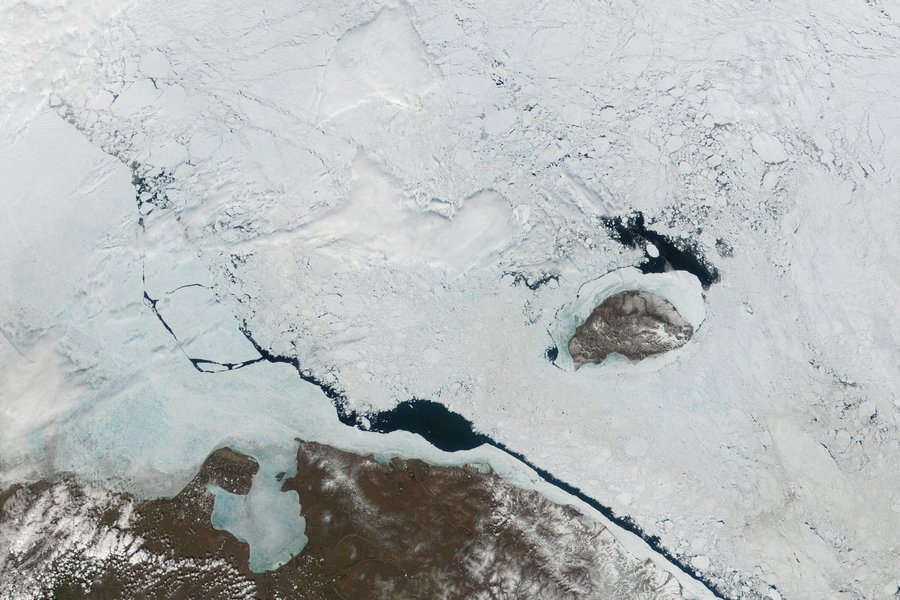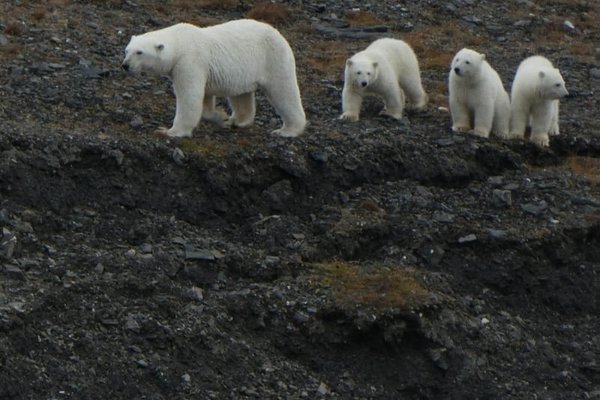Russia
Wrangel Island
The Natural System of Wrangel Island Reserve comprises a group of two islands north of the Arctic Circle with a remarkably high diversity of plants and animals.
Wrangel Island and Herald Island lie in the High Arctic Tundra ecoregion, with a very dry and cold climate and a mountainous landscape. The islands were not glaciated during the last Ice Age and subsequently served as a refuge for Pleistocene species that had not survived elsewhere. Biodiversity is high considering its location, with a large breeding Snow goose population, up to 100,000 congregating Pacific walrus and many Polar bear dens.
Community Perspective: Only visited yearly by very few people – Sherry shares the feeling of setting foot on this island.
Site Info
Official Information
- Full Name
- Natural System of Wrangel Island Reserve (ID: 1023)
- Country
- Russia
- Status
-
Inscribed 2004
Site history
History of Wrangel Island
- 2004: Inscribed
- Inscribed
- 2003: Requested by State Party to not be examined
- 2001: Requested by State Party to not be examined
- At Bureau Session
- Type
- Natural
- Criteria
- ix
- x
Links
- UNESCO
- whc.unesco.org
- Official
-
- wild-russia.org — Wild Russia: Wrangel Island
- Related
-
- siberiantimes.com — Lunch arrives on Wrangel Island, and 230 polar bears show up for the feast
- mammalwatching.com — Trip report (2013)
- mrfaucher.blogspot.nl — Trip report (2014)
All Links
UNESCO.org
- whc.unesco.org — whc.unesco.org/
Official Website
- wild-russia.org — Wild Russia: Wrangel Island
Related Resources
- siberiantimes.com — Lunch arrives on Wrangel Island, and 230 polar bears show up for the feast
- mammalwatching.com — Trip report (2013)
- mrfaucher.blogspot.nl — Trip report (2014)
- archive.org — The First Landing on Wrangel Island (Project Gutenberg)
- eglinpix.com — Link
- en.wikipedia.org — Link
News Article
- Oct. 5, 2017 newsweek.com — Over 200 Polar Bears Filmed Feasting on Whale Carcass in Bowhead Banquet
- Aug. 20, 2014 en.itar-tass.com — Russian Pacific Fleet stations naval base on Wrangel Island
Community Information
- Community Category
- Wildlife habitat: Fauna
- Natural landscape: Insular
Travel Information
Takes more than 5 days to visit
Reservation required
One thousand visitors or fewer
Recent Connections
-
Incorrect UNESCO 'Number of locations'
Comprises 2 separate areas: Wrangel Isl…
-
Full White Nights
-
Strict Nature Reserve
Fully. " In the past some 200 a year us…
Connections of Wrangel Island
- Geography
-
-
Arctic
-
Uninhabited islands
Except for ca. "27 full and part time staff". Presumed never inhabited. -
Arctic Ocean
-
Disputed territories
By some groups in USA -
Isolated WHS
1600 Kms from Kamchatka Volcanoes -
Full White Nights
-
Formerly inhabited islands
The remains of early Paleo Eskimo camps are not thought to be evidence of permanent year round habitation. However, in 1926 the Soviet Union set up the village of Ushakovskoe with 60 transplanted peoples (mainly Chukchis) to boost its claim for sovereignty over this uninhabited island in the face of possible US and Canadian claims. With the loss of "Soviet" backing the village declined through the 1990s and in 1997 the majority of those remaining were transported to the mainland, though the village operated through to 2003 when it was formally closed (in time for its WHS inscription!) and those currently living on the island are considered transitory Nature Reserve employees rather than "permanent" residentsSee ru.wikipedia.org
-
- History
-
-
Neolithic age
Chertov Ovrag site: "On Wrangel Island, the earliest Neolithic site without pottery, Chertov Ovrag, was [sup.14]C dated to c. 3400 BP"See go.gale.com
-
Once Claimed for the USA
"A party from the USRC Corwin landed on Wrangel Island on August 12, 1881, claimed the island for the United States and named it "New Columbia". The expedition, under the command of Calvin L. Hooper, was seeking the Jeannette and two missing whalers in addition to conducting general exploration. It included naturalist John Muir, who published the first description of Wrangel Island." In 1916 Tsarist Russia claimed the island and in 1924 the USSR established a base there. -
Castaways or shipwrecked mariners
Several occasions. "In 1914, the survivors of (an) ill-equipped Canadian Arctic Expedition, were marooned there for nine months after their ship, the Karluk was crushed in the ice pack. The survivors were rescued.... after (the) Captain walked across the Chukshi Sea to Siberia to summon help" (from Wiki). An expedition of 5 people went to the island in Sep 1921 as "settlers" in an attempt to claim it for Canada. "Running out of provisions, 3 members tried in Jan 1923 to cross the Chukshi Sea to get help from Siberia - they were never seen again. The remaining man was incapacitated by scurvy and was cared for by Ada Blackjack, the Inuit cook, eventually dying in April 1923 leaving Ada alone until she was rescued in August when an organiser of the expedition arrived." (from Wiki) Ada lived on in Anchorage until 1983!
-
- Ecology
-
-
Bears
Polar bears -
Icebergs
-
Seals
bearded seal -
Tundra
-
Steppe
... a mosaic of tundra and steppe types co-exist in quilt-like patterns (AB ev) -
Mammoths
From carbon dating of bones found there it is considered the last pre-extinction refuge of Mammoths. See -
Bird Migrations
OUV: The islands have the largest sea-bird colonies on the Chukchi Sea, are the northernmost nesting grounds for over 100 migratory bird species including several that are endangered such as the Peregrine falcon -
Refugium
"was not glaciated during the Quaternary Ice Age. It served as a refuge for Pleistocene species, and remnant species not present elsewhere are still to be found on Wrangel." (AB ev) -
Strict Nature Reserve
Fully. " In the past some 200 a year used to arrive by boat and make short tours of the island’s coast and waters, outside the Reserve, guided by qualified scientists. A 13 sq.km area around the village is designated a recreational zone excluded from the Reserve and can be visited without restriction. The rest of the Reserve can only be visited with permission from the Reserve administration offices at Mys Shmidta near Pevek on the mainland (where a museum and visitor centre are proposed)." (UNEP-WCMC) -
Whales
Feeding ground for the Gray whale -
Mammal Migrations
El Vizcaino and Wrangel island are the northern and southern "ends" of the Grey whale migration
-
- Damaged
-
-
Threatened by Oil and Gas Exploration
"Recent research indicates that the hydrocarbon potential in the South Chukchi Basin may be significantly higher than previously suggested. ... The interplay of oceanic advection, limited emergency response capacities and arctic weather conditions suggests that Wrangel Island, including important polar bear habitat, would likely be affected by spills even in considerable distances from the site." (IUCN Outlook 2020)
-
- World Heritage Process
-
-
Incorrect UNESCO 'Number of locations'
Comprises 2 separate areas: Wrangel Island and Herald Island
-
Natural sites filling gaps cited by IUCN
Tundra
-
- WHS on Other Lists
-
-
Located in a TCC Territory
Russia in Asia -
Plant WHS not in a CPD
"The number and type of endemic plant species, the diversity within plant communities, the rapid succession and mosaic of tundra types,...in the small geographic space are all visible evidence of Wrangel’s rich natural history and its unique evolutionary status within the Arctic" (OUV)
-
- Timeline
-
-
Late Pleistocene
the latest separation of the island from the mainland took place about 10000 years ago.
-
- Visiting conditions
-
-
Takes more than 5 days to visit
Cruises take about 14 days for a roundtrip -
Reservation required
Access requires a special permit -
One thousand visitors or fewer
“Only one tourist group consisting of 6 people visited the Island during the last 3 years, though over the previous 5 years the Reserve received 9 “terrestrial groups” (2 to 15 people) and 8 cruise vessels (40 to 80 people each).” (nom file)
-
- WHS Names
-
-
Named after individual people
the island was named after Baron Ferdinand von Wrangel (1797-1870), who, after reading Andreyev's report and hearing Chukchi stories of land at the island's coordinates, set off on an expedition (1820-1824) to discover the island, with no success (wiki)
-
News
- newsweek.com 10/05/2017
- Over 200 Polar Bears Filmed Feasti…
- en.itar-tass.com 08/20/2014
- Russian Pacific Fleet stations nav…
Community Reviews
Show full reviews
One small step for man and one giant step for mankind is what danced in my head as I set foot on the Wrangel Island tundra and the earth beneath me moved. It was like walking on a sponge, soft and light; almost delicate feeling. However the tundra was anything but delicate. I had just set foot on an island that only a few hundred people have ever seen or walked on. A visit to Wrangel Island is truly a unique once in a lifetime experience.
In fact getting there is the hard part! This is the hard part. You need a special permit to be able to visit the island granted by the Russian authorities. This is not an easy process unless you know someone. However Heritage Expeditions run 3 cruises a summer (in August) to Wrangel Island on their polar vessel, the Spirit of Enderby.
While we visited, 3 Russian rangers came on board our Heritage Expeditions ship and stayed for 4 nights while we made our way around the island. They accompanied us on landings both for educational purposes and for safety purposes. They also showed us images of what life was like for them in the winter which was fascinating. Polar Bears get quite curious in the winter and many visited the ranger buildings quite often. I felt weird when we left them knowing that they had a long cold winter ahead.
Keep reading 0 comments
